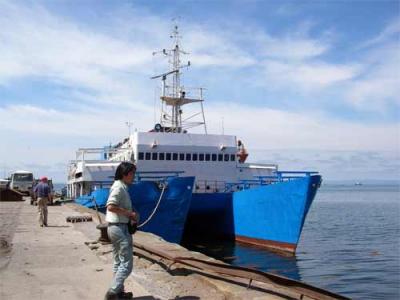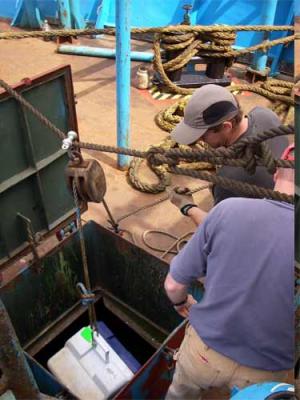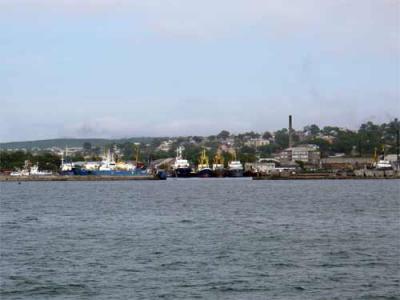We got up at our usual time – about 6 am – ate breakfast and got the rest of the gear packed up. Then we set to cleaning the apartment. By about 8:30 we had the major tasks accomplished and decided to wait until about 9:30 or so to move our gear downstairs and sweep out the rest of the living areas, since we were expecting to be picked up at about 10 am. We were only mildly surprised when the bus arrived for us early at 9:00 – that is how "schedules” often go with field work!
After loading our gear on the bus, we stopped by the Institute to pick up two Russian scientists, Dmitry Frolov, from the Russian Academy of Sciences in St. Petersburg, and Nikolai Vasilenko, who works at the Institute in Yuzhno-Sakhalinsk, and then by the hostel to pick up the Japanese scientists, Mitsuhiro Nagagawa, Ahira Baba, geologists from Hokkaido University, Yoshihiro Ishizuka, who works for the Japanese geological service, and Taku Osaka, an archaeologist from Tokyo. By about 10 am we headed south out of Yuzhno-Sakhalinsk toward the port town of Korsakov with a rather full bus load of people and gear.
The trip to Korsakov is about 45-60 minutes and we had to stop here and there throughout town to locate the ship and to verify that our passport clearances were completed. So it wasn’t until about 1 pm that we finally passed through the passport control office and walked down the dock to our ship – the Iskatel.
The Iskatel
 Our first view of the Iskatel-4, a Russian catamaran vessel that will
take us to the Kuril Islands. Iskatel means "Seeker" in Russian.*
Our first view of the Iskatel-4, a Russian catamaran vessel that will
take us to the Kuril Islands. Iskatel means "Seeker" in Russian.*
The Iskatel is a catamaran ship, which means that it has a split hull with two large pontoons on the front. It is nearly as wide as it is long, but has a very shallow draft, meaning that bottom of the hull is not very deep below the surface of the water.
We unloaded the bus, had a quick bite to eat in the galley and then moved our gear into the starboard forward hold. The only entry to the hold is through a hatch with a ladder that is about 12 feet long, so we had to rig a pulley to help lower the coolers and duffels full of gear down to the floor of the hold.
Moving Gear
 Mike Etnier (left) and Colby Phillips (right) use a pulley
to help lower gear down to the hold on board the Iskatel.
Mike Etnier (left) and Colby Phillips (right) use a pulley
to help lower gear down to the hold on board the Iskatel.
By 4:30 all of the rest of the scientific crew was aboard, we had been assigned bunks and gear was stowed. By 5:20 we were pulling away from the dock and on our way to the Kurils. We were leery of how the Iskatel would do as we crossed the Sea of Okhotsk because we had heard not so exciting tales of how rocky and unstable she had been with the first crossing….
Korsakov Port
 The port of Korsakov, near the southern end of Sakhalin Island.*
The port of Korsakov, near the southern end of Sakhalin Island.*
Da Svidanya! Misty

